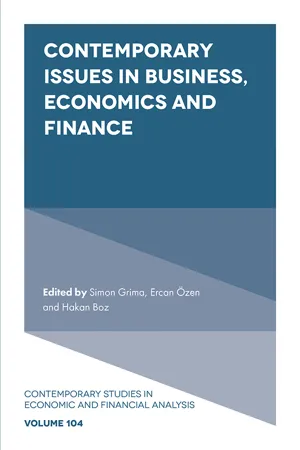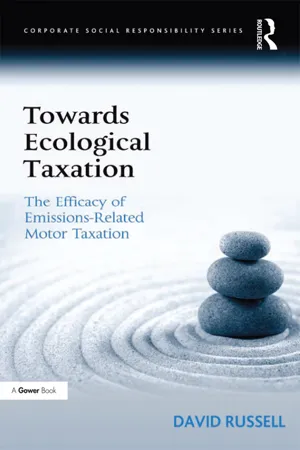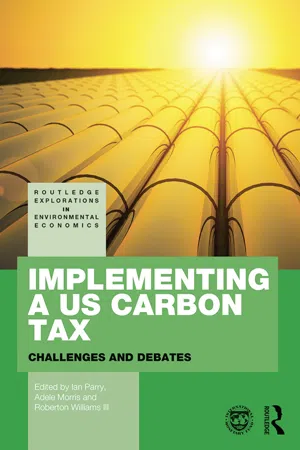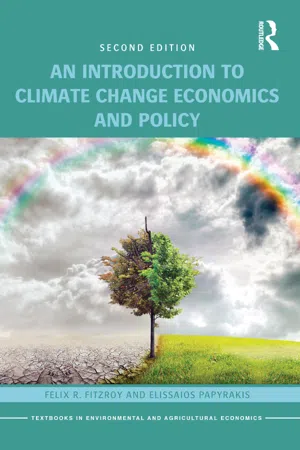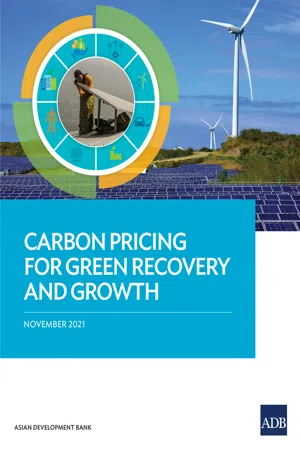Carbon Tax
A carbon tax is a fee imposed on the burning of carbon-based fuels, with the aim of reducing carbon dioxide emissions. It is designed to incentivize individuals and businesses to reduce their carbon footprint by increasing the cost of activities that contribute to climate change. The revenue generated from the tax can be used to fund environmental initiatives or offset other taxes.
8 Key excerpts on "Carbon Tax"
- eBook - ePub
- Arnaud Brohé(Author)
- 2017(Publication Date)
- Routledge(Publisher)
...Carbon Taxes are taxes assessed on the basis of the carbon content of energy sources (Elbeze and de Perthuis, 2011) and rates are expressed as a monetary unit per tonne of CO 2. These taxes aim to change the relative prices of goods or energy sources, on the basis of their CO, content, in order to steer decisions made by actors towards low carbon production and consumption. This type of tax may be primarily motivated by a desire to regulate diffuse emissions, however other factors explain its appeal to many governments. For example, it is a new source of resources for the state, particularly as company tax rates have dropped. Supporters of Carbon Taxes argue that tax structures should be modified to reduce taxes deemed to cause distortions, such as taxes on earned income (Bosquet, 2000). For fossil fuels, Carbon Taxes are also a way of intercepting rents on oil and other fuels (Elbeze and de Perthuis, 2011). At this point, it is important to be clear about the fundamental difference between Carbon Taxes and energy taxes. Whereas Carbon Taxes have a direct effect on CO, emissions, energy taxes aim to rationalize energy use whatever the carbon content. A legislator can decide to tax these two areas in a complementary way An increasing number of European countries and Canadian provinces have imposed a tax on CO, emissions. Finland was the first country to introduce a Carbon Tax in 1990. Sweden, Denmark, the Netherlands and the United Kingdom followed, with reforms that moved the fiscal burden from labour to CO 2 emissions and energy consumption. These environmental taxes have increased progressively in Europe, now accounting for 25 billion EUR of income, which has made it possible to reduce labour taxation (Ekins and Speck, 2011). These countries were joined more recently by Switzerland (2008) and Ireland (2010) (Elbeze and de Perthuis, 2011). During this time, the tax rate has increased progressively but significantly...
- eBook - ePub
- Brian Dawson, Matt Spannagle(Authors)
- 2008(Publication Date)
- Routledge(Publisher)
...Carbon Tax A Carbon Tax is a specific tax levied on each unit of carbon dioxide (CO 2), or carbon dioxide equivalent (CO 2 e) of other greenhouse gases, emitted to the atmosphere. It is normally levied at a rate per tonne—for example, $ 10/tonne CO 2. As with emissions trading, the primary objective of a Carbon Tax is to establish a cost penalty on greenhouse gas emissions (normally referred to as a carbon price). Introducing a cost penalty on emissions is one of a suite of options available to help reduce emissions. Carbon Taxes alter the relative prices of goods and services according to the embodied emissions associated with their production and/or consumption (see emissions intensity). In the case of electricity, a $ 10 Carbon Tax would increase the cost per kilowatt hour (kWh) of electricity from coal fired power plants by nearly 1 cent/kWh, efficient gas turbines by 0.5c/kWh, while the cost of electricity from renewable energy and nuclear power would remain largely unchanged. In an emissions intensive electricity system such price increases provide a financial incentive to reduce electricity consumption (e.g. through energy efficiency), substitute for less greenhouse gas intensive electricity products (e.g. electricity from renewable sources), or a combination of these—whichever way greenhouse gas emissions are reduced. If the Carbon Tax is low, consumers may just choose to pay the higher costs and demand may not change significantly...
- Simon Grima, Ercan Özen, Hakan Boz, Simon Grima, Ercan Özen, Hakan Boz(Authors)
- 2020(Publication Date)
- Emerald Publishing Limited(Publisher)
...It is also claimed to be the most powerful policy tool on sustainable development. Listed below are the reasons why Carbon Tax is supported by countries (Acosta, 2015): Allowing public revenue. Providing environmental effectiveness. Transparent and simple. Economic efficiency. Accurate costs. A Carbon Tax is a charge on the combustion of carbon-based fuels such as coal, oil and greenhouse gases. The aim is to reduce the use of fossil fuels that damage the climate and cause global warming. At this point, Carbon Tax is seen as the only way to pay for the climate damage caused by the release of carbon dioxide in the atmosphere. The Carbon Tax set to a sufficiently high value rewards those who do not use these fuels economically. Therefore, it becomes an element that motivates the use of clean energy (CTC). The tax to be applied for greenhouse gas emissions needs to be handled in a broad context in terms of both efficiency and justice principles. For example, home heating systems, factories, airplanes, power plants and cars should have the same carbon price. But this also leads to the following challenges (Marron et al., 2015): Presence of greenhouse gases other than carbon dioxide. Difficulty in tracking emissions. There are multiple ways to generate carbon emissions. The need to extend credit for the purpose of removing carbon emissions from the atmosphere. Consequently, according to the analysis, Carbon Tax encourages investments to be made for clean energy, as well as reducing carbon pollution. However, there are doubts as to how low-income communities will be affected by the Carbon Tax due to these positive characteristics as well as the negative impact it has on social welfare (Carbon Tax Forum; Chi, Ma, & Zhu, 2012)...
- eBook - ePub
Towards Ecological Taxation
The Efficacy of Emissions-Related Motor Taxation
- David Russell(Author)
- 2016(Publication Date)
- Routledge(Publisher)
...This may determine a different total price for particular fossil fuels that may not reduce carbon emissions, either through fuel substitution or efficiency. Accordingly, a Carbon Tax may be more effective if levied as a rate with a base rate assigned to the lowest carbon content fossil fuel (natural gas) with rates proportionate to their carbon content for oil and coal (Kaufmann 1991). However, a careful modelling of end-user prices to gauge precisely the outcome of a Carbon Tax on CO 2 emissions would be necessary. The introduction of a Carbon Tax in the UK would change relative prices and this would have an effect on the international competitiveness for products (Ekins 1994). Tulpule et al. (1998) also observed that (notwithstanding the opportunity for fuel substitutability) carbon emission penalties (possibly in the form of taxes) would increase production costs for emission intensive industries. This would lead to higher prices for consumers. Ekins (1999) suggested that the use of economic instruments, such as Carbon Taxes, should not increase the overall burden of taxation for businesses which would adversely affect business competitiveness. He adds a caveat that such impact on environmentally intensive sectors is part of the essential purpose of environmental taxation, in order to persuade these sectors to make more efficient use of scarce resources and to simultaneously pursue new, less environmentally demanding products and processes. A Carbon Tax may affect the relative competitive trade position, particularly for those parts of the economy that are heavily dependent on fossil fuels, for example manufacturing, by increasing the price of industrial inputs and, as a consequence, increased prices of consumer goods (Pearson & Smith 1990)...
- eBook - ePub
Implementing a US Carbon Tax
Challenges and Debates
- Ian Parry, Adele Morris, Roberton C. Williams III, Ian Parry, Adele Morris, Roberton C. Williams III(Authors)
- 2015(Publication Date)
- Routledge(Publisher)
...Even industries that directly emit little or no carbon dioxide (CO 2), such as auto manufacturing, are still affected, because they use as inputs goods produced by other industries that do emit CO 2 (e.g., steel). Industries that are formally subject to a Carbon Tax (e.g., fuel suppliers) can be expected to pass along at least part (and perhaps all) of that tax to consumers of their products. This is part of why a Carbon Tax is an economically efficient way to reduce carbon emissions: not only do the direct users of fossil fuels have an incentive to reduce emissions, but the pass-through of the tax means that industries and consumers who buy goods that are carbon-intensive in production also have an incentive to shift to less carbon-intensive alternatives (e.g., buying more energy-efficient appliances in order to use less electricity). However, this also means that a Carbon Tax implicitly acts as a tax on factors of production (primarily labor and capital). Some portion of the tax is “passed backward,” lowering wages for labor, returns on capital, and the prices of other inputs in production. Another portion is “passed forward,” raising the prices of both consumer and capital goods. Either way, the effect is to lower the real return to those factors of production, thus reducing the incentive to work, save, and invest. 4 This leads to somewhat lower levels of GDP, employment, and other measures of economic activity. For example, Goulder and Hafstead (2013) suggest that imposing a Carbon Tax with an initial rate of $10/ton 5 and rising at 5 percent/year would cause the level of GDP 20 years later to be roughly 0.6 percent lower than it would have been in the absence of the tax. 6 That may sound bigger than it really is: keep in mind that it is a difference in GDP levels, whereas we are used to hearing about GDP growth rates...
- Felix R. FitzRoy, Elissaios Papyrakis(Authors)
- 2016(Publication Date)
- Routledge(Publisher)
...In many countries there is frequently a widespread public distrust of government and a general perception that public revenues are often wastefully or fraudulently used – such a ‘fee and dividend’ scheme can at least partly alleviate such concerns. The huge income transfers from the rest of the world to the fossil fuel producing countries, and the various negative consequences, will obviously also be reduced by carbon fees or taxes. While national schemes would of course be the easiest to initiate, and in the biggest polluters like the US and China could also have a global mitigation impact, the ideal, globally harmonized Carbon Tax runs into the same kind of international coordination problems we discussed in the previous chapter. While the principle of Carbon Taxation has gained strong support from economists across the political spectrum, agreement on an adequate level and rate of increase of this tax will also be much more difficult. In Chapter 9, we explain why the widely discussed ‘marginal social cost of carbon’ (as the ‘optimal’ Carbon Tax) is not a meaningful concept in the face of potentially catastrophic climate change. Instead, the priority must be to minimize the probability of catastrophe, combining economic and political considerations to maintain public support for radical mitigation. The ‘optimal’ Carbon Tax is just one component of a package of policies subject to political constraints, which cannot be defined by the usual ‘optimal tax’ calculations (and not least because the ultimate penalty includes the destruction of human civilization). Regulation Mandatory requirements, such as insulation and efficiency standards for buildings and appliances, cannot cater for differences in individual tastes or technology, and are therefore often criticized by economists as ‘command-and-control’ measures...
- eBook - ePub
The Case for a Carbon Tax
Getting Past Our Hang-ups to Effective Climate Policy
- Shi-Ling Hsu(Author)
- 2012(Publication Date)
- Island Press(Publisher)
...Chapter 4 Arguments against a Carbon Tax The fact that Carbon Tax proposals have failed to advance in North America suggests that alternatives are more currently more popular. At least cap-and-trade proposals have passed the US House of Representatives, seen the light of day in the US Senate, and been the topic of discussion in various Canadian federal and provincial governments. Most outside of the Carbon Tax tent (but inside the camp favoring action on climate change) favor cap-and-trade, most of the remainder favor government subsidies (without necessarily using that term), and a few, mostly environmental advocates, still favor the use of command-and-control regulation (also without specifically calling it that). In the United States, some environmental organizations still call for regulation of greenhouse gas emissions through the existing command-and-control-oriented Clean Air Act. Whether emanating from a sincere belief in the efficacy of command-and-control, or from a strategic desire to use command-and-control as leverage for obtaining passage of cap-and-trade legislation, this has become a distinctly minority view. Putting aside for the moment the question of public acceptance of the need for greenhouse gas legislation, to the extent that policy is moving toward greenhouse gas reductions, it does not seem poised to arrive via a Carbon Tax. Clearly, objections to a Carbon Tax go beyond those mentioned in passing in the previous chapter. Here, the book turns to the case against Carbon Taxes. This chapter describes counterarguments to the ten arguments made in chapter 3, as well as responses to these counterarguments. Political Economy Considerations Very generally speaking, the study of political economy is the application of economic theory to the behavior of actors in political and administrative contexts. Political economy is the combination of economics and political science...
- eBook - ePub
- (Author)
- 2021(Publication Date)
- Asian Development Bank(Publisher)
...The price signals created through carbon pricing lead firms, consumers, and investors to incorporate the social and environmental costs associated with their market decisions. Those decisions, in turn, can influence the quantity of greenhouse gas (GHG) emissions generated throughout product life cycles, from resource to waste. As a result, the entire economy can become less carbon-intensive, by incentivizing consumers and producers to adjust their decisions to reflect the climate externality. To obtain the same result with non-market-based instruments would require regulation that reflects complete information about emissions and abatement options for all polluting processes and behaviors, and detailed regulatory controls. This is extremely difficult to achieve and involves huge governance costs. Carbon pricing addresses the heterogeneity of emitters, reducing overall emissions and the cost of abatement. Compared to other types of policy instruments, carbon pricing can address the vast heterogeneity of GHG emitters, thus helping to minimize the cost of pollution control. Heterogeneity results from firms providing diverse goods and services using a range of different technologies and inputs, and thus causing different quantities of emissions per unit of output. This translates into unequal marginal costs across firms of mitigating GHG emissions. When faced with paying a price for polluting, firms generally attempt to maximize profits by choosing the cheapest production route (i.e., minimizing costs). That involves, within the limits of capital constraints, reducing their emissions until achieving additional reductions becomes more expensive than paying the carbon price. When the cost of mitigation is passed on to consumers through the price of goods and services, the firms whose total cost of mitigation measures, together with the lowest carbon price paid, become more competitive...


